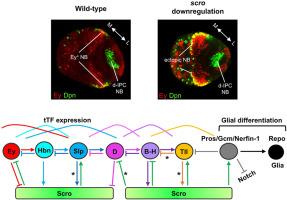Scarecrow, a homolog of mammalian Nkx2.1, regulates the temporal progression and glial differentiation of medulla neuroblasts for the optic lobe development in Drosophila melanogaster
IF 2.1
3区 生物学
Q2 DEVELOPMENTAL BIOLOGY
引用次数: 0
Abstract
The Drosophila medulla is the largest structure in the adult visual nervous system. It contains a vast population of interneurons comprising over 80 different cell types generated by medulla neuroblasts (NBs). Aging NBs express a series of temporal transcription factors (tTFs) that contribute to neuronal diversity. Recent studies have shown that an NK-2 homeobox gene scarecrow (scro) works as a tTF covering from middle to late temporal windows; however, how its expression is established over multiple windows and what roles it plays in individual windows remain largely elusive. We found the lack of scro expression in the middle of the Dichaete (D) domain, implying its expression is not in a continuum as previously eluded. Overexpression and knockdown assays of scro or other tTFs using various tTF-Gal4 drivers further revealed distinctive roles played by Scro at each window, including the last one. The oldest NBs positive for Tll and Scro found at the most proximal region of the developing medulla field attained expression of Gcm (the master factor of glial differentiation) and Nerfin-1 (a suppressor of dedifferentiation via Notch suppression), which in turn led to NB-to-glia differentiation. Downregulation of either gcm or nerfin-1 resulted in the formation of ectopic NBs at the expense of glial cells. Moreover, scro-knockdown led to a loss of Gcm, Nerfin-1, and Prospero expression, misregulation of Notch expression, formation of ectopic NBs, and a substantial reduction in glial cell population, suggesting that Scro acts upstream of Gcm and Nerfin-1. The chromatin-immunoprecipitation (ChIP) assays support that Scro regulates the expression of gcm, nerfin-1, and pros, as well as several tTFs, the expression of which overlaps with Scro. In summary, this study not only verified previously suggested roles of Scro but also uncovered novel features of this gene in various temporal windows, including the promotion of NB-to-glial transition and discontinuous expression within the D domain.

稻草人是哺乳动物Nkx2.1的同源基因,调节黑腹果蝇视叶发育中髓质神经母细胞的时间进展和胶质分化。
果蝇的髓质是成人视觉神经系统中最大的结构。它含有大量的中间神经元,由髓质神经母细胞(NBs)产生的80多种不同的细胞类型组成。衰老的NBs表达一系列有助于神经元多样性的时间转录因子(ttf)。最近的研究表明,NK-2同源盒基因稻草人(scro)在中后期的时间窗中起tTF覆盖作用;然而,它的表达是如何在多个Windows上建立的,以及它在单个Windows中扮演什么角色,在很大程度上仍然是难以捉摸的。我们发现Dichaete (D)结构域中间缺乏scro表达,这意味着它的表达不像以前所回避的那样是连续的。使用各种tTF-Gal4驱动因子的scro或其他ttf的过表达和敲低实验进一步揭示了scro在每个窗口(包括最后一个窗口)发挥的独特作用。在发育中的髓质场最近端区域发现的Tll和Scro阳性的最古老的NBs表达了Gcm(胶质分化的主要因子)和Nerfin-1(通过Notch抑制去分化),从而导致nb向胶质细胞分化。gcm或nerfin-1的下调都会导致异位NBs的形成,而胶质细胞则会受损。此外,Scro敲低导致Gcm、Nerfin-1和Prospero表达缺失,Notch表达失调,异位NBs形成,胶质细胞数量大幅减少,表明Scro作用于Gcm和Nerfin-1的上游。染色质免疫沉淀(ChIP)分析支持Scro调节gcm、nerfin-1和pros以及几种与Scro表达重叠的ttf的表达。总之,本研究不仅验证了之前提出的Scro的作用,而且揭示了该基因在不同时间窗口中的新特征,包括促进nbto胶质的转变和D域内的不连续表达。
本文章由计算机程序翻译,如有差异,请以英文原文为准。
求助全文
约1分钟内获得全文
求助全文
来源期刊

Developmental biology
生物-发育生物学
CiteScore
5.30
自引率
3.70%
发文量
182
审稿时长
1.5 months
期刊介绍:
Developmental Biology (DB) publishes original research on mechanisms of development, differentiation, and growth in animals and plants at the molecular, cellular, genetic and evolutionary levels. Areas of particular emphasis include transcriptional control mechanisms, embryonic patterning, cell-cell interactions, growth factors and signal transduction, and regulatory hierarchies in developing plants and animals.
 求助内容:
求助内容: 应助结果提醒方式:
应助结果提醒方式:


